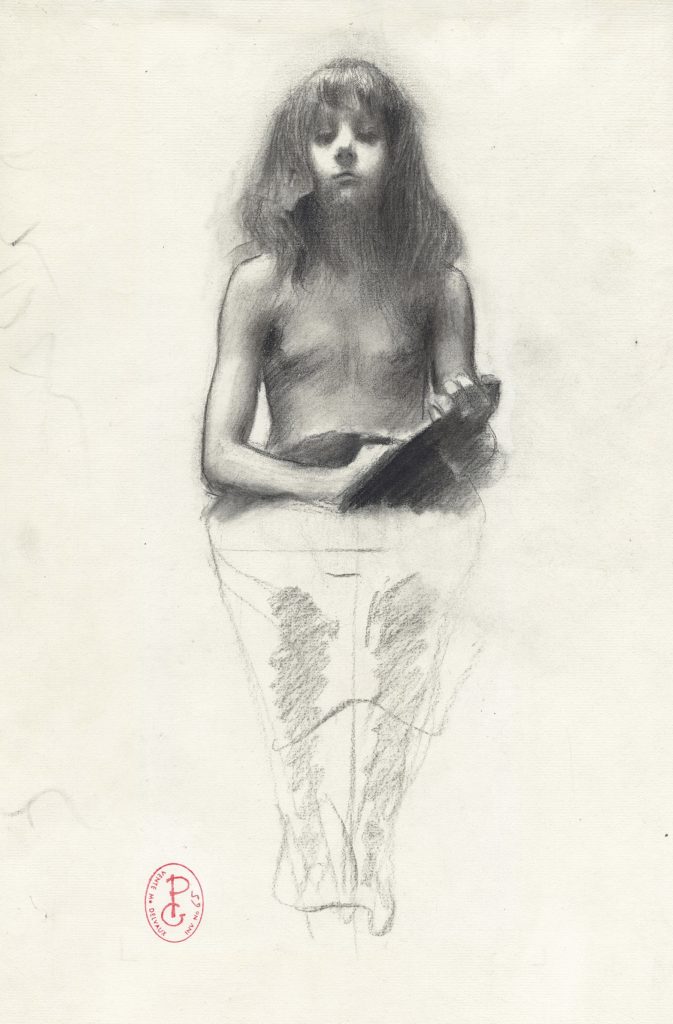Études pour un plafond à l’Hôtel de Ville de Paris (Galerie Lobau), titré Allégorie de l’Histoire
Studies for a ceiling of the Hôtel de Ville in Paris (Galerie Lobau), entitled Allegory of History
Charcoal on laid paper, ca. 1891-1898
With the red stamp of the artist studio sale on the lower left (Lot 65, Lugt 3209)
Size
280 x 445 mm; 270 x 450 mm
Provenance
Artist’s studio; Thence by descent; Private collection, France
Exhibition
These two fascinating girls are somewhat curious. They stand out from the academism prevailing at the end of the 19th century and adopt the naturalistic preoccupation with a touch of fin-de-siècle aesthetic. As the messy hair show, their strange beauty is not idealized. While one is quietly reading – or more likely writing down something –, the other one is staring at us as if she was jaded by her era. With their still juvenile faces and apparent breast, they are not putti, young angels very often present in allegorical ceilings, nor they are full grown up feminine creatures which were appreciated at the time.
The artist, Georges Picard, was born into a Jewish family from Eastern France (Vosges). He arrived in Paris in 1877, and first trained in Jean-Léon Gérôme’s studio at the École des Beaux-Arts of Paris. Even though he exhibited at the Salon des Beaux-Arts in 1888, it’s only with the prestigious and important commission of the eighteen domes of the Galerie Lobau of the Hôtel de Ville in Paris – the City Hall – that Picard became notorious. The previous City Hall had burned in 1871 and the public authorities wanted the new building’s interiors to be decorated with a brand-new program. On the 17 of April 1891, Picard – associated with the decorator Charles Risler – won the contest with 24 votes on 31 and received a premium of 120,000 Fr.
Picard’s decoration project depicts the story of Lutecia through a complex iconographic program[1]. The two present girls were drawn as studies for the pendentives of the dome dedicated to the allegory of History. There, Picard added wings to his two figures and placed them over a vegetal background. Each of the 18 domes has indeed four pendentives where Picard chose to represent allegorical children. The corridor was finished in 1898 and received from the Commission de décoration the highest praise[2]. Thanks to the satisfaction of this jury, Picard was entitled to work on several buildings, either private or public: the Salon de l’Europe of Monte Carlo’s casino (1898); the Embassy of France in Vienna (1905); the South Pavillion of the Petit Palais (1906) or the Teatro Colón of Buenos Aires. The 1890’s, period during which Picard completed the two girls, were a milestone in the artist’s evolution. The Petit Palais owns several studies for the Galerie[3], including several children, but the two present drawings are of a far more delicate and intriguing completion.
[1] The Birth of Paris, The Fight, The Antic Knowledge, Spring, Poetry, Art, History, Philosophy, 1789, Science, Industry, The Awakening, Peace, Beneficence and The World Expositions.
[2] « Les plus vifs éloges » (cf. A.D.A.C., PV. Com. Décor., 14 décembre 1898).
[3] Georges Picard, Esquisse pour la galerie Lobau de l’Hôtel de Ville de Paris : L’Art. L’Histoire. La Philosophie. La Révolution française. La Science, 1890, oil on canvas, Paris, Petit Palais, musée des Beaux-arts de la Ville de Paris, inv. PPP4211







